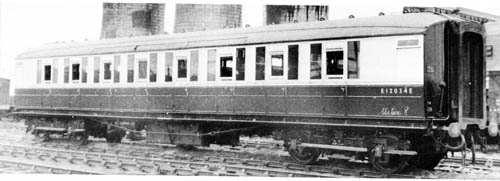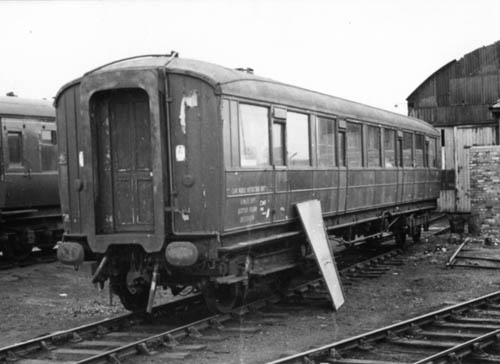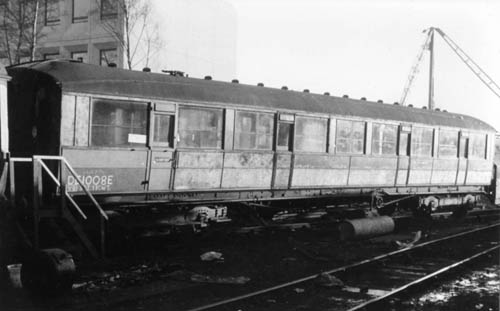
Introduction
Gresley designed Corridor Third no. 10021 was built at York Carriage Works in 1924 to
LNER Diagram 23. It carried various numbers during
its service life.

Photo is a scan from Michael Harris' "Gresley's Coaches 1905-53" of a Diagram 23 coach
Alastair McPhee wrote an article for Blaspipe in the "Hidden Gems" series - here is an extract
Third corridor No 1002 was built in 1924, just one year after the formation of the
LNER itself. It is thus an important vehicle because it represents a design introduced
right at the start of the production of the standard vehicles. It was built to Diagram
23, and interestingly enough, within this diagram there were variants: for instance,
there was a version with three as side seating for the East Coast main line, and another
version with four a side seating in the compartments for the local areas. Approximately
100 of these carriages were produced in the 1924 capital build programme. The design can
perhaps best be described as almost entirely Great Northern, but with some modifications
which pointed the way forward to later developments. The body is manufactured entirely of
teak, which according to contemporary accounts, was chosen for its durability and
availability. In common with similar carriages, the roof is domed at each end above the
vestibules, buckeye couplings are fitted, and Pullman gangways. These work by compression,
unlike the more prevalent British Standard gangways which had to be drawn out to meet
and then clipped together. The underframe is notable, too, because it is based on
earlier GNR designs and thus has the older round truss bars. These are actually
adjustable, in order to maintain the stresses in the steel underframe itself. The
bogies are of the notable double bolster Gresley pattern with pressed steel frames
called Spencer - Moulton bogies, as the suspensions were designed by this firm.
Although complex in construction and expensive to maintain, they gave a superb ride
and were still being used under new electric units well into the 1960's.
1002 was built at York carriage works, and ran in front line passenger service, being
renumbered 12041 in 1943. Upon nationalisation of the railways in 1948, it was
re-numbered SC12041E and continued to operate until 1963. Thus, the initial capital
investment made in 1924 gave nearly forty years continuous service - a return which is
unlikely to be mirrored in today's environment. It was rebuilt at Cowlairs in 1963 and
converted into a staff riding van. All but one of the compartments and the side corridor
were removed at that time and most of the compartment side doors screwed permanently
shut. It was purchased by a group of SRPS members in 1971, and rather quickly converted
into a dormitory coach for use at Falkirk by those working over the weekend. I can well
recall spending several rather uncomfortable nights in it myself!

1002 shortly after arrival at Falkirk 27.2.71. Photo H Stevenson.

At Falkirk, 11.1.78, numbered DE1008 for a filming move. Photo H Stevenson.
Below is a series of photos I took before we started "restoration" just to give you an idea of "where we are coming from". Sorry for the clichés. Click on any thumbnail to view larger or start a slideshow. All photos by DGC and are at native resolution, so download may be slow.